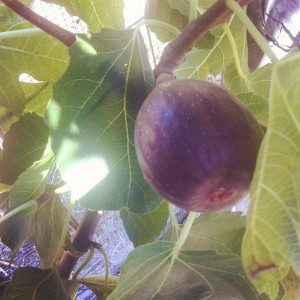I’ve been thinking about water this week. The worst American drought for half a century is ravaging the nation, threatening to turn much of the country into a dust bowl. And it’s been hot and humid in the garden, in the 90′s and pushing 100 some days, which is very hot for our temperate, moderate, mountain coastal climate zone. And we’re doing plumbing work at the Ranch, so the combination of these factors has made me think about the water the plants drink every day, via the irrigation system, and via my hose and watering can.
I’m a great believer in hand-watering whenever possible. Of course, in the real world, we’re busy people, so it’s pretty much essential to have a drip or sprinkler irrigation system to ensure no days are missed. But if there’s time, it’s best to water by hand.
Not only do you get to judge by eye, by smell and by instinct the exact water amount to feed your charges, but you also get to see how they’re doing. As the gardener waters, they look at the plants. I notice details, like pests and mildew, and like ripening fruit and shoots that should be plucked. And I connect with the plants on a spookier level that can only be experiential, can never be explained. But in short, the plants are like everyone else: they love high quality attention, and they love to be observed and fed. They love love. It makes them grow strong and healthy and delicious and lovely.
Our plants are particularly lucky, because the water they drink is well water drawn from the water table that’s under this property. It’s 100% pure, non-chlorinated, and as local as it could possibly be.
While I’m a fan of progress, and while I love the excitement of space exploration, I’m only too aware that NASA’s base is upstream of Los Angeles, and that L.A’s tap water contains traces of rocket fuel. The standard issue tap water in Southern California isn’t great, which is fair enough, because it’s basically the desert, so shouldn’t be expected to be rain water or straight from the source. But when it comes to growing veggies, it’s probably worth considering your water source, because not only will the plants be stronger and more disease-resistant if they drink great water, but I also imagine the edible parts of the plants will be more nutritious and luscious if the water they’re grown with is sweet and pure. It’s easy to leave a big container out in the garden to collect rainwater. Easy and free.
Despite the lovely water, an infestation of plant bugs recently arrived in the garden due to the heat. It’s the first infestation we’ve had in the garden since Spring, so we’ve done pretty well. And considering that one sixth of America’s corn crop has just been lost to pestilence in less than one month, including corn that was genetically modified to be pest-resistant (but obviously isn’t)… well considering the conditions we’re gardening under, with this humid heat, it’s probably to be expected that we have a few bugs. And we do.
The Latin name for the ones in the garden here in Malibu is Miridae, and the common name is horrible plant bugs. The kale was bound to fall prey to insects as the heat rose, and that’s what happened this week. All of the kale had to be pulled out and destroyed this week, so there won’t be any more kale until cool Autumn days. Completely infested. Beyond even feeding to the chickens, it was so crawling with disgusting critters.
We do have some Swiss chard and ruby chard left, but probably only enough for this week. And there is a bed of arugula doing its best to grow, with shade cloth and seaweed fertilizer to help it, but it doesn’t look very strong. Oh, and the butter lettuces look absolutely amazing for some unknown reason! No idea why they’re enjoying the sun and heat so much, but they’re growing exponentially and have no sign of bolting or bitterness. Let’s hope the plant bugs don’t find them. If they do, I have organic insect spray, and I’m not afraid to use it (sparingly). It’s basically oil, and it fries the insects. Mean and green.
We have a bed of heat-tolerant New Zealand spinach and Malabar spinach to tide us over with greens for the next few weeks, but other than these semi-succulents, it’s slim pickings for the greens until cooler days, due to the combination of temperatures too high to germinate most greens seeds, and the insect issue.
We do have an abundant supply of onions and leeks, tomatoes and tomatillos are delighted, summer squash and cucumbers are going bananas, citrus trees are pumping out fruit, eggplants and chile peppers are taking over, and maybe most excitingly, the figs and apples are starting to ripen.
Currently growing but not ready to be harvested yet are bell peppers, corn, lima beans, melons, pumpkins of many kinds (Musque de Provence, Galeux d’Eysine, et cetera!), and a selection hard-skinned winter squash, including butternut and delicata.
I’m starting to plan our earliest cool weather crops. I’d like to plant seeds in flats at the end of August or by the beginning of September for our first Autumn crops, so our seed order needs to be made this week.
It’s still too early to sow hardier Winter crops, like onions and garlic, but lots of others can be started soon. Here’s what I’m planning to sow in the next few weeks:
Turnips
Kohl Rabi
Cauliflower
Cabbage
Peas
Spinach
Lettuces
Kale
Parsnips
Leeks
Cilantro
Parsley
I’ll continue to plant these all-year-round crops:
Beets
Chard
Radishes
Carrots
Okay, off to continue the war against the Miridae… Amor vincit omnia!





